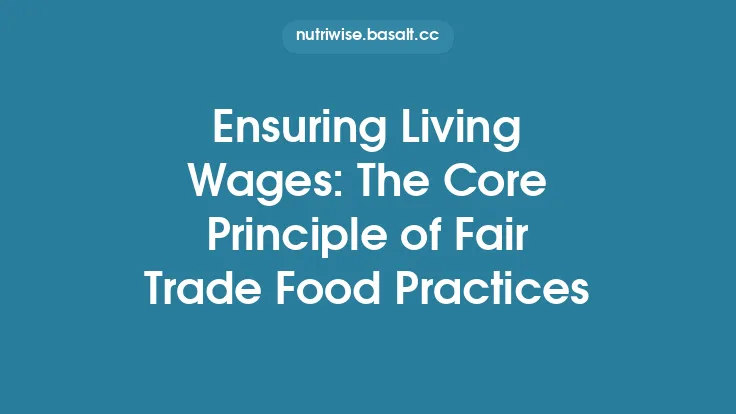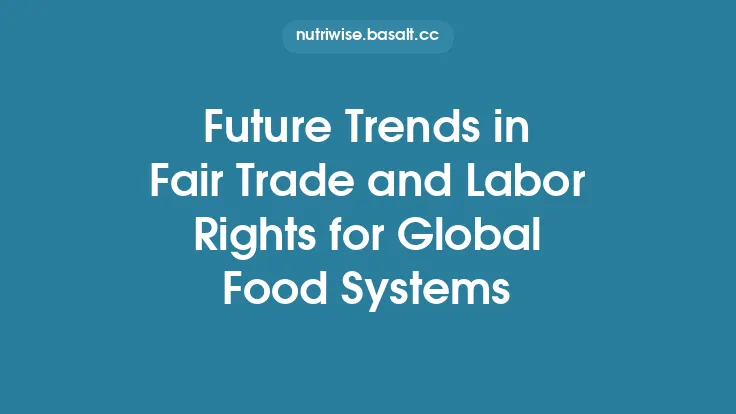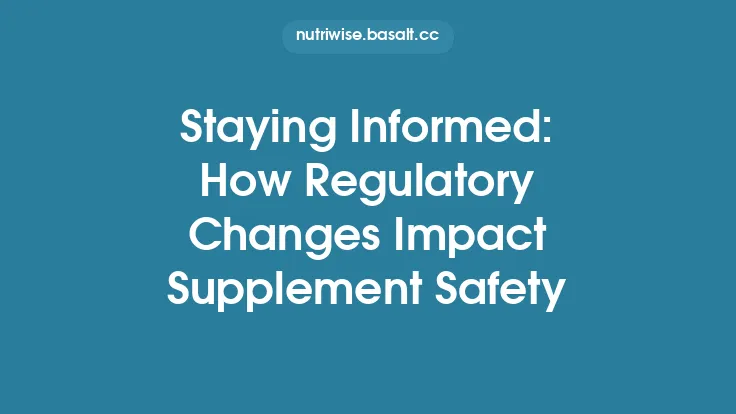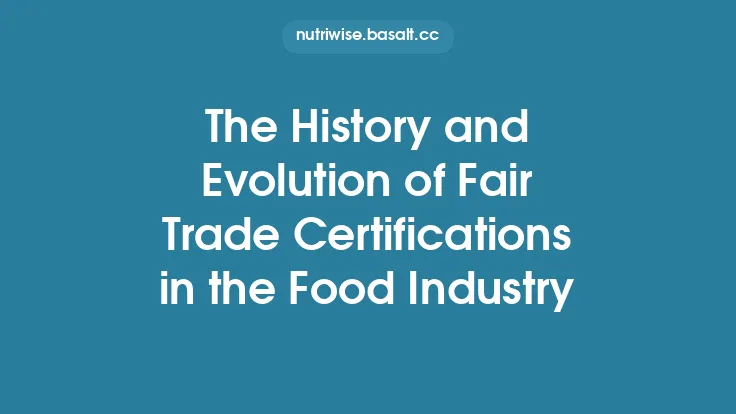Fair Trade food initiatives have moved beyond certification symbols to become engines of tangible change for producers, their families, and entire communities. By linking market access with social and environmental standards, these programs generate ripple effects that reshape livelihoods, health, education, and local economies. The stories below illustrate how Fair Trade‑linked projects translate principles into measurable outcomes, offering a roadmap for anyone interested in the real‑world impact of ethical food systems.
Economic Empowerment and Poverty Reduction
Fair Trade premiums and guaranteed minimum prices give producers a safety net against volatile commodity markets. In the highlands of Peru, a cooperative of quinoa growers that adopted Fair Trade standards in 2012 reported a 23 % increase in average household income within three years. The premium—allocated to community projects—funded a small‑scale irrigation system that boosted yields by 18 %, allowing families to sell surplus grain at higher prices.
In Ghana’s cocoa sector, Fair Trade certification has enabled smallholders to negotiate a price floor 15 % above the regional average. Longitudinal studies using panel data show that participating farms experience a reduction in extreme poverty incidence from 38 % to 22 % over a five‑year period, largely due to higher and more predictable cash flows. The extra income is often reinvested in farm inputs, diversifying production and reducing reliance on a single cash crop.
Health and Nutrition Improvements
Stable earnings translate into better food security and health outcomes. In the Philippines, a Fair Trade rice cooperative introduced a nutrition education program funded by the Fair Trade premium. Over four years, the prevalence of moderate to severe anemia among women of reproductive age fell from 27 % to 14 %, as households incorporated more diverse, nutrient‑rich foods into their diets.
Similarly, a Fair Trade tea estate in Assam, India, used premium funds to construct a community health clinic. Routine health screenings revealed a 30 % decline in water‑borne illnesses after the clinic introduced safe‑drinking‑water filters and hygiene workshops. These health gains are documented through mixed‑methods evaluations that combine household surveys with biometric data, providing robust evidence of impact.
Education and Youth Opportunities
Education is a cornerstone of long‑term community resilience. In Bolivia, the Fair Trade quinoa network allocated part of its premium to build a secondary school in the remote municipality of Caracollo. Since its opening in 2015, school enrollment among children aged 12‑16 rose from 58 % to 92 %, and female enrollment increased from 55 % to 89 %. The school also offers agricultural science classes that teach sustainable farming techniques, linking education directly to improved production practices.
In Ecuador’s banana‑growing region, a Fair Trade‑linked youth apprenticeship program pairs teenagers with experienced growers. Participants receive stipends and hands‑on training in post‑harvest handling, marketing, and entrepreneurship. Evaluations show that 80 % of apprentices start their own micro‑enterprises within two years, diversifying income sources and reducing youth migration to urban centers.
Gender Equality and Women’s Leadership
Fair Trade standards require equitable participation, and many projects have turned this requirement into a catalyst for women’s empowerment. In Tanzania’s coffee sector, a women‑only Fair Trade cooperative introduced micro‑credit schemes funded by the premium. Over a three‑year cycle, women’s average savings grew by 45 %, and female‑owned businesses expanded from 12 to 38.
Beyond finance, leadership roles have shifted. In a Fair Trade tea garden in Sri Lanka, women now hold 45 % of the management positions, up from 12 % before certification. Decision‑making bodies incorporate gender‑sensitive policies, such as flexible work hours for mothers, which have been linked to a 15 % increase in overall labor productivity.
Community Infrastructure and Resilience
Infrastructure projects financed by Fair Trade premiums often address long‑standing gaps in rural areas. A case study from Nicaragua’s cacao region illustrates this: the premium funded the construction of a solar‑powered water pumping station, providing reliable irrigation for 150 hectares of cacao farms. The resulting yield increase of 22 % helped buffer the community against drought years, as confirmed by satellite‑derived vegetation indices.
In addition, road improvements in a Fair Trade vanilla cooperative in Madagascar reduced transport time to the nearest market from 6 hours to 2 hours. This logistical gain lowered post‑harvest losses by 28 %, directly enhancing farmer incomes and food availability.
Environmental Stewardship Linked to Fair Trade
While the primary focus of this article is on social outcomes, environmental benefits often accompany them, reinforcing community well‑being. In Mexico’s Fair Trade avocado orchards, producers adopted shade‑grown practices that preserve native tree cover. Biodiversity surveys recorded a 35 % rise in bird species richness within five years, supporting ecosystem services such as pollination and pest control.
In Kenya, a Fair Trade coffee cooperative introduced soil‑carbon sequestration techniques—cover cropping and reduced tillage. Soil testing revealed an average increase of 0.8 % organic carbon over three planting cycles, improving soil fertility and reducing the need for synthetic fertilizers, which in turn lowers production costs for farmers.
Market Access and Business Development
Fair Trade certification opens doors to premium markets that would otherwise be inaccessible. A collective of small‑scale quinoa growers in Bolivia secured contracts with three major European retailers after certification, resulting in a 40 % price premium over non‑certified sales. The cooperative used the additional revenue to invest in a processing facility, adding value locally and creating 25 permanent jobs.
In the Philippines, a Fair Trade coconut oil producer leveraged certification to enter the organic cosmetics market in North America. Export volumes grew from 5 tons to 18 tons annually within four years, illustrating how market diversification can stabilize incomes and reduce dependence on a single buyer.
Cultural Preservation and Indigenous Knowledge
Fair Trade projects often respect and revitalize traditional agricultural practices. In the Andean highlands, quinoa farmers maintain ancient seed‑saving rituals that preserve genetic diversity. The Fair Trade premium funds a community seed bank, safeguarding over 200 heirloom varieties. This repository not only protects cultural heritage but also provides a buffer against climate‑induced crop failures.
Similarly, in Indonesia’s spice islands, Fair Trade cooperatives document and share indigenous pest‑management methods, such as the use of neem extracts. These practices reduce chemical pesticide use, aligning with both cultural values and environmental health.
Measuring Impact: Methodologies and Indicators
Robust impact assessment is essential for translating anecdotal success into credible evidence. Most Fair Trade projects employ a mixed‑methods framework:
- Baseline Surveys – Conducted before certification to capture household income, health status, education levels, and environmental conditions.
- Counterfactual Analysis – Using matched control groups (non‑certified farms) to isolate the effect of Fair Trade participation.
- Longitudinal Tracking – Annual follow‑up surveys that monitor changes over time, allowing for trend analysis.
- Participatory Monitoring – Community members are trained to collect data on key indicators (e.g., water quality, school attendance), fostering ownership and ensuring data relevance.
- Remote Sensing – Satellite imagery assesses land‑use changes, forest cover, and crop health, providing objective environmental metrics.
Common indicators reported across projects include:
- Household income growth (%)
- Prevalence of food insecurity (FIES score)
- School enrollment and completion rates
- Incidence of water‑borne diseases
- Gender parity indices in leadership roles
- Soil organic carbon (SOC) levels (g kg⁻¹)
By triangulating quantitative data with qualitative narratives, researchers produce comprehensive impact reports that guide future interventions and inform stakeholders.
Looking Ahead: Scaling Impact
The stories above demonstrate that Fair Trade food initiatives can generate lasting, multidimensional benefits. Scaling these successes requires:
- Strategic premium allocation to address community‑identified priorities.
- Capacity‑building for producers to manage finances, negotiate contracts, and adopt sustainable practices.
- Partnerships with local NGOs, research institutions, and government agencies to amplify resources and expertise.
- Transparent reporting that shares impact data with consumers, reinforcing the market demand for ethically produced food.
When these elements align, Fair Trade moves from a certification label to a catalyst for systemic change—empowering producers, safeguarding health, preserving culture, and nurturing the environment for generations to come.





